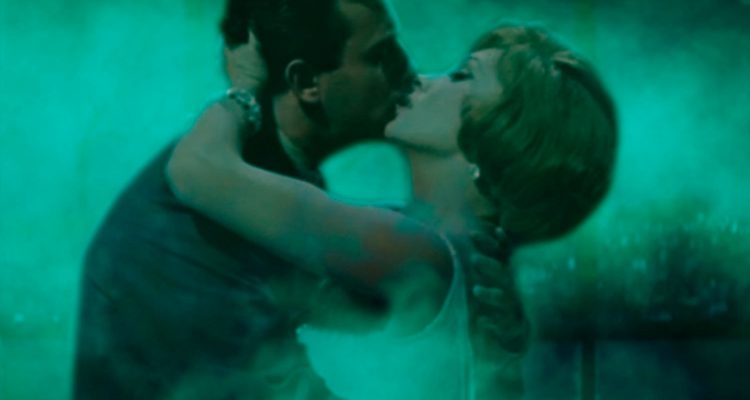“The Green Fog” may be described as little more than a clip show homage to both Alfred Hitchcock’s “Vertigo” and the cinematic history of San Francisco, but its charming, playful attitude and occasional dips into pathos provide an unexpected buoyancy. Originally commissioned by the San Francisco Film Society, which simply wanted a celebratory collage highlighting San Francisco on the screen throughout the years, the film took a different shape under the guidance of Guy Maddin and his collaborators, Evan and Galen Johnson. With only a few months to put together the project, Maddin and the Johnsons watched hundreds of movies and television episodes, before ultimately deciding to structure it around the most well-known San Francisco movie of all: “Vertigo.”
While billed by some as a remake, “The Green Fog” doesn’t match Hitchcock shot for shot: it follows through thematically, emotionally, and, with the aid of a Jason Garchik original score performed by the Kronos Quartet, it feels more like a symphonic adaptation than a purely cinematic one. A muted musicality rings throughout, capturing the tempo of “Vertigo” rather than attempting a cinematic carbon copy. The result is eerie, funny, and strangely compelling, pulling the audience through a disjointed alternate dimension of Hitchcock’s masterpiece.
The title refers to the green aura and mist in the original film surrounding the transformation of Judy Barton back into Madeleine Elster. Here, Maddin and the Johnsons add their own green fog via CGI throughout the film, which takes various forms: a oneiric, Gatsbian pulsating; a psycho-sexual sickly hue of lust and greed; a mist of impenetrable mystery. It’s most apparent in the prologue, casting a creepy atmosphere over the rest of the proceedings, as San Francisco is literally seen in a new light.
Yet the impending sense of dread is soon dispelled by one of the film’s most distinctive and welcome features: its method of cutting conversations. In order to properly re-tell “Vertigo,” the directors needed characters and conversations on screen – yet most of the dialogue from other films would prove irrelevant to their purpose. Therefore, they cut the clips of conversations to remove the dialogue, leaving behind a compendium of awkward gestures; mouths open and close like gasping fish, and eyes constantly search in response to words which no longer exist. Its immediate effect is laughter: the cuts are so abrupt and unexpected that the transformation of each scene is one of new, strained tensions and incongruous body language which constantly elicits giggles from the audience.
Eventually, however, the perspective shifts as the film adjusts to the rhythm of the cuts, and these wordless encounters take on a weighty affectation. Particularly surprising in this regard is the film’s inclusion of Chuck Norris, whose acting prowess, stripped of his speech and superhuman martial arts, is exhumed by the larger context of “The Green Fog” and “Vertigo.” (Galen Johnson has jokingly described the performance as accidentally Bressonian).
It’s also all the more startling when we do see and hear voices as if the spell that had been cast over the film suddenly dissipated. Maddin and the Johnsons include an NSYNC music video to great effect, as well as other meta jokes — a young Michael Douglas from “Streets of San Francisco” watching a clip of his own naked body on screen from “Basic Instinct” (which slips into a clip of Eadweard Muybridge’s explorations of motion and the body), saying “looking good, Mike.” While it never conjures up the full power of Hitchcock’s film, “The Green Fog” manages to reach a feverish, frenzied pitch, providing the transformation and death in “Vertigo” with a literalized social context as a destructive force. We not only see dozens of women forced to change their appearance to suit the whims of men, but lust and greed on a larger scale as well; gentrification and social upheaval, displayed by footage of natural disasters —even clips from “Godzilla” make an appearance — reveal the tacit implications of the original film. Beyond its novel use of elided conversations, this is where “The Green Fog” comes into a film of its own, beyond the ever-widening gyre of Hitchcock’s silhouette. As Maddin and Co. expand the socio-economic subtext of “Vertigo” (and San Francisco itself, over the years), the familiar streets which “The Green Fog” has been running up and down begin to spread out into new territory.
Yet there’s only so far Maddin can take the conceit, and the restrictions of the project hold down the film’s ambitions. Surprisingly dense, “The Green Fog” is a compelling curiosity of a film which yearns for more than its original programming, yet it will likely struggle to become more than a perfect amuse-bouche for a festival setting. Vacillating between a playful comedy and a brooding melodrama, it’s a wonderful example of how one can work within the confines of homage yet emerge with a unique work in its own right. [B+]
Browse through all our coverage of the 2018 Berlin International Film Festival by clicking here.

